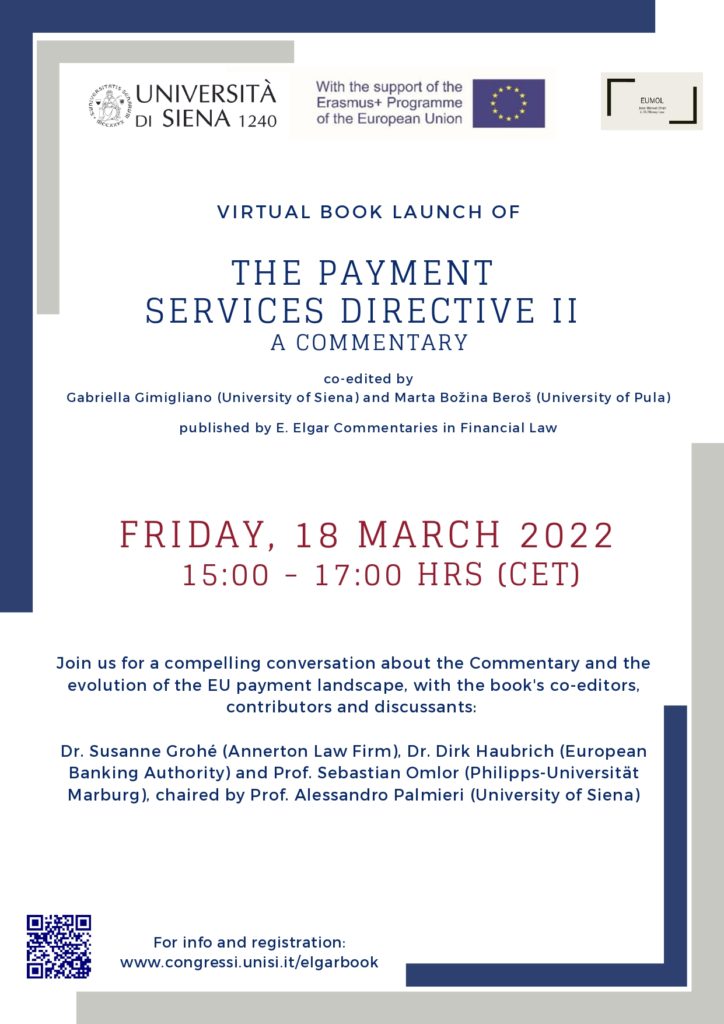A Commentary on the Second Payment Service Directive and the Ancillary Legal Framework
Edited by Dr. Gabriella Gimigliano and Dr. Marta Bozina Beros, Elgar Commentary Series.
Published by Edward Elgar, and falling under the funding framework of the Jean Monnet Chair in EU Money Law, the volume on the 2015 Payment Service Directive (the so called, PSD2), in light of the general framework for the EU payment law will be edited by Dr Gabriella Gimigliano (University of Siena, JM Chair leader) and Dr Marta Bozina Beros (Juraj Dobrila University of Pula) .
Considering that the literature in the field of EU payment law is yet to be fully established and would clearly benefit from a detailed elaboration of one of its central regulatory instruments. At present, there is no comprehensive analysis of PSD2 (it is the same for 2007 PSD that has been replaced by the PSD2), but there are also few legal tailor-made essays on one or more aspects of the directive concerned. The commentary will examine the provisions of the PSD2, through a novel, systematic approach, giving priority to a critical cross-title analysis whenever necessary. The editors believe this approach is best suited to illustrate the important conceptual connections across the PSD2 titles as well as the close and vital links between the PSD2 and other European sources of law pertinent to this field. A couple of examples help illustrate the editors’ aim:
- The concept of “payment service providers”, provided in PSD2, covers both banking and non-banking financial institutions; some of the non-banking financial institutions are covered by the PSD2 provisions, others are regulated by a different European directive, the so called 2009 EMI directive concerning the Electronic Money Institutions. Our systematic approach allows us to cover both categories of non-banking payment service providers, despite the fact that they are primarily regulated by different sources of EU law;
- The provision of payment services is a regulated activity and the PSD2 provisions consequently cover authorities competent of licensing and exercising the tailor-made oversight. However, the relevant legal rules are laid down in two different PSD2 titles (title II and title V, respectively): our approach allows us to investigate both of the competent authorities within a same chapter, i.e., a chapter devoted to the provision of payment services and the role of national and European supervisory authorities, which arguably facilitates the understanding of this multilevel framework as well as enhances the book’s accessibility.
Therefore, the proposed commentary on the PSD2, will provide that the normative analysis of the PSD2 legal framework is integrated, where necessary, by reference to:
- The preliminary rulings issued by the Court of Justice of the European Union;
- The EBA guidelines and regulatory technical acts;
- The complementary European directives or regulations, for example, the 2009 EMI directive, the 2014 basic bank account directive, the geo-blocking regulation, whenever such referencing allows a more comprehensive understanding to the readers.
Part I analyses the PSD2 directive, while Part II investigates the transposition of PSD2 in a selected number of Member States (and in the United Kingdom).
Forthcoming in September 2022: Money Law, Capital, and the Changing Identity of the European Union
Edited by Gabriella Gimigliano and Valentino Cattelan.
This book addresses three questions: is money a way to create a European Union identity? If so, which type of identity is this? And in what ways is the EU identity changing? The book brings together experts from a variety of backgrounds and academic approaches to analyse the law of money and payments on the one side, and the law of capital and investments on the other.
The book is divided into two parts. Part I covers scriptural, electronic and
digital money. It analyses the European framework for payment services users, explores limits and challenges of the Banking Union, and looks at the project for a digital euro. Part II investigates the policy and regulatory drivers of the EU’s changing identity, from the early modern roots of the European law of money and capital to the regulatory strategy set in the Capital Markets Union and the role conferred on venture capital; from the FinTech-based developments of payment systems to the newly-established fiscal and monetary policies in the post-COVID phase.
The book will be of interest to researchers, academics and policy makersin the fields of law and regulation, as well as political economy and political
sciences.
Looking forward to the book presentation on 3-4 November 2022!


